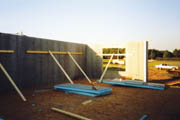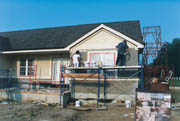
"My main trade is EIFS application," states Mike Isaac, of H&I Construction, located in Waynesville, Ohio. "And while there may be the potential to do some residential EIFS, the insurance situation makes it tough."
This is the sentiment echoed time and again across the United States at industry shows, association meetings and in trade publications. There are options, however, for contractors willing to learn and conform to the ProTEC concrete structural insulated panel system.
"We're confident we can resurrect the EIFS industry," says Dick Crawford, director of business development for T.Clear Corp., Hamilton, Ohio. "This combination panel can give the old EIFS look without the new EIFS problems."

No more wood
Crawford contacted Isaac when a 2,500-square-foot residential project came about requiring an EIFS-like exterior finish. T. Clear's SIPS uses Util-A-Crete concrete backer board for the exterior and interior skins of the panel, rather than the more common OSB panels. The core material consistes of Dow Chemical Styrofoam brand extruded polystyrene insulation. Util-A-Crete cement board laminated to each side of the core allows exterior finishes such as stucco, textured acrylic coatings finishes, synthetic stone, thin brick and various plank sidings, to be directly applied to the cement board exterior surface."My first concern was cost," explains Isaac. "The material cost of panel per square foot was up there but with no foam, no drainage system, the time and labor savings more than made up for the material cost."
The exterior finishes for this project were an EIFS-type finish and synthetic stone directly applied to the cement board. There was no need for metal lath to be applied for the synthetic stone application.
"When you put up a panel, you're putting up the framing, sheathing, insulation, interior wall surface and electrical raceways, a full R-20 wall," explains Jeff Ketterer, product manager for ProTEC. "It's damage resistant, and mold and mildew resistant. The panel passed ASTM D 3273-94, the standard for mold and mildew resistance. We tested entire panels-not just one surface."
As mentioned by Isaac, material costs are offset by the speed of construction: A typical 2,500 square foot house, attended to by a four-man crew, can have it ready for floor joists or roofing contractors in a day.

Happy together
Having spoken to several EIFS manufacturers, Ketterer and Crawford say their reactions are "ecstatic and enthused.""There are no real points of leakage, it's all sealed," Crawford adds. "We recommend contractors embed mesh in a liquid waterproof around all window and door openings and panel joints of the exterior. The interior you just tape with nylon or fiberglass drywall tape, embed in mud and finish the wall. Keep paper out as a potential source for mold."
There is no need for building wrap as the vapor drive through the panel is .8 perms, well below that provided by most building wraps that show values of 50-plus perms.
The panel incorporates a steel structure consisting of an H stud, and top and bottom tracks. Trusses and floor joists are secured to the top of the panel with various clips as manufactured by Simpson or USP. Once the panels are set in place and the steel track and H stud are inserted into the panel Styrofoam core, a special nail developed by ITW Buildex is pneumatically driven through the concrete backer board and into the steel supports. These are placed 8 inches on center around the perimeter of the panel and on both the inside and outside.
Contractors needn't worry about extra work on the inside either: The inside of the panel wall requires only taped joints and skim coat. The electrical boxes even arrive precut on the job site.
Isaac undertook the proper training and is very happy with how the project turned out. In fact, Crawford and Ketterer plan to be cautious with this product. Although the product inherently lacks some of the risks of traditional EIFS improperly installed, the manufacturers still plan to limit the sale of their products to contractors qualified and current with correct construction procedures.
"We're not going to get greedy," Crawford says. "The only contractors installing this product will be properly trained and approved."
Indeed, Crawford wants to make sure that his product is never marred by inferior installers. As for Isaac, he sees the SIPs as a new lease on the residential market.
"I'm building this way from here on out," he says. "It's not for every design but it's definitely going to open me back up to work and insurance. It's not EIFS. It's the EIFS look without the EIFS problems."
